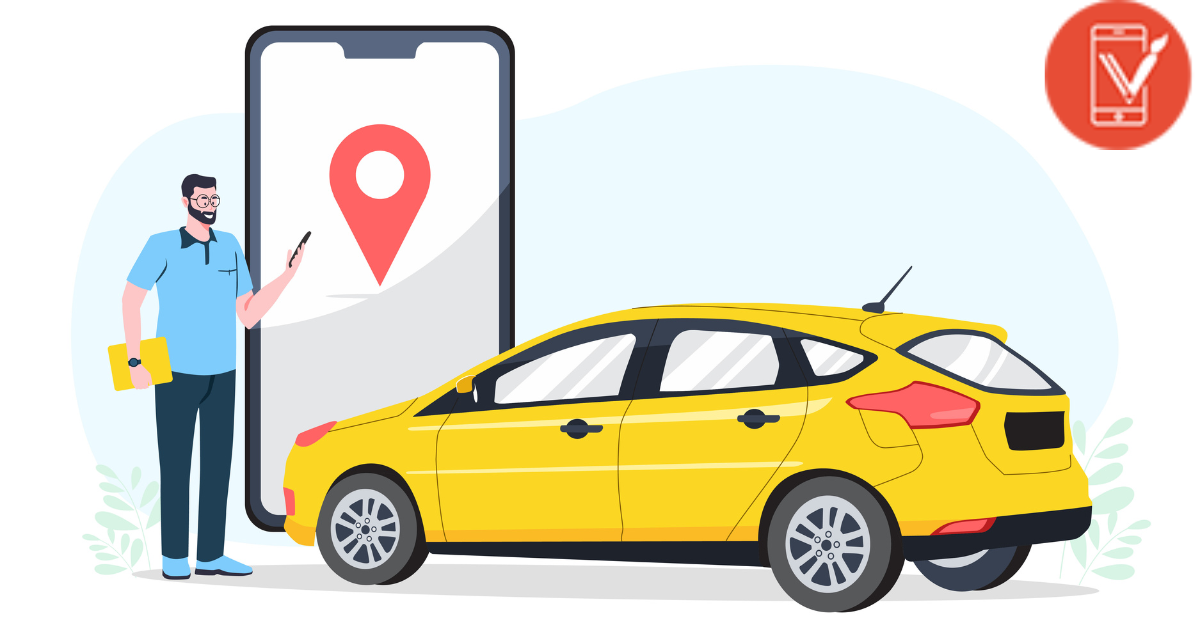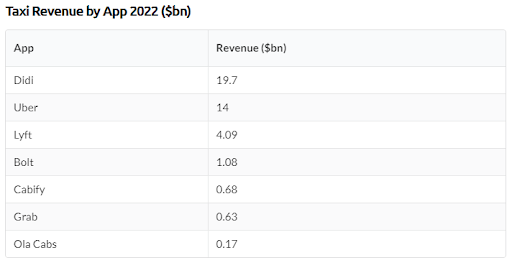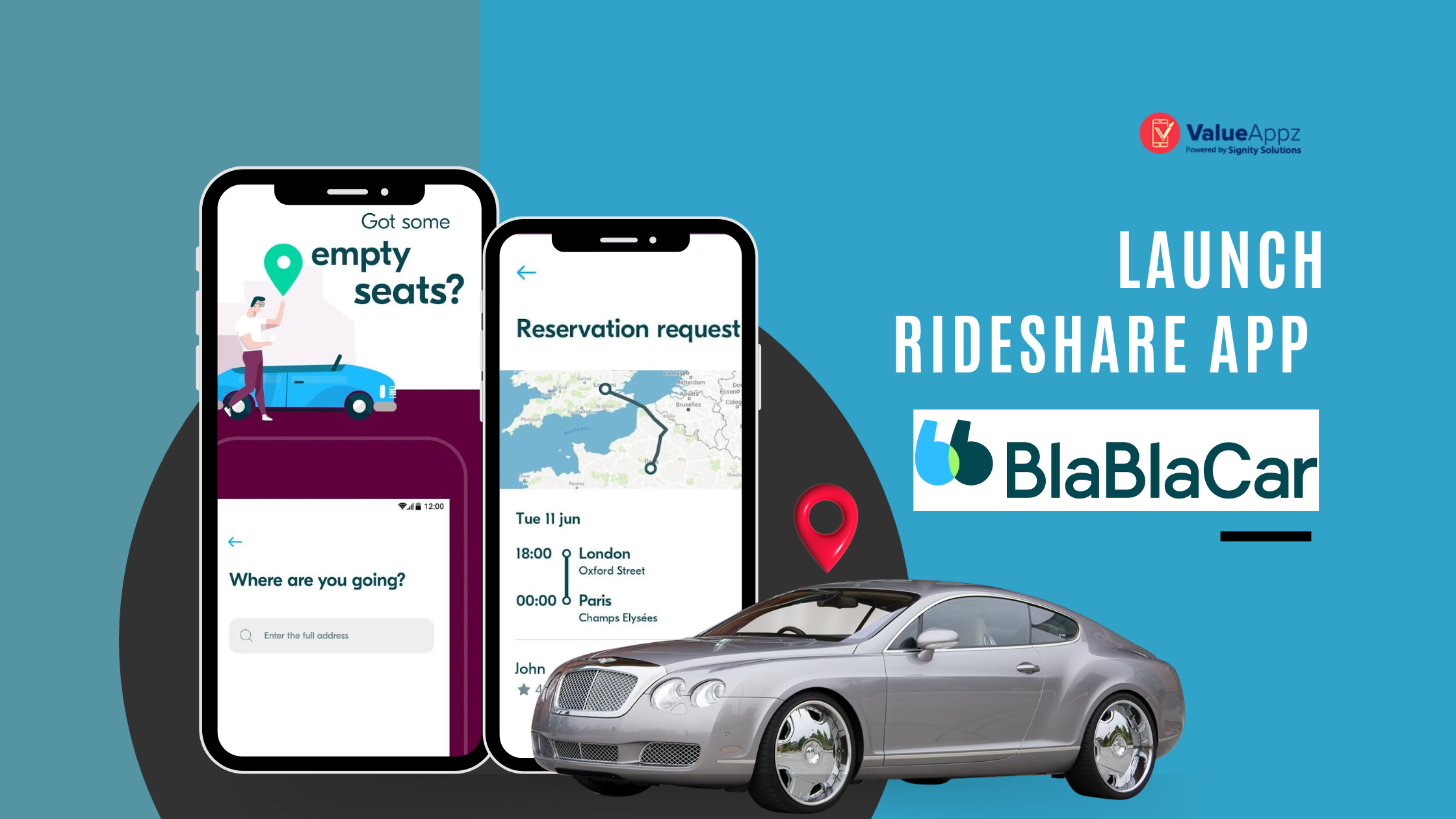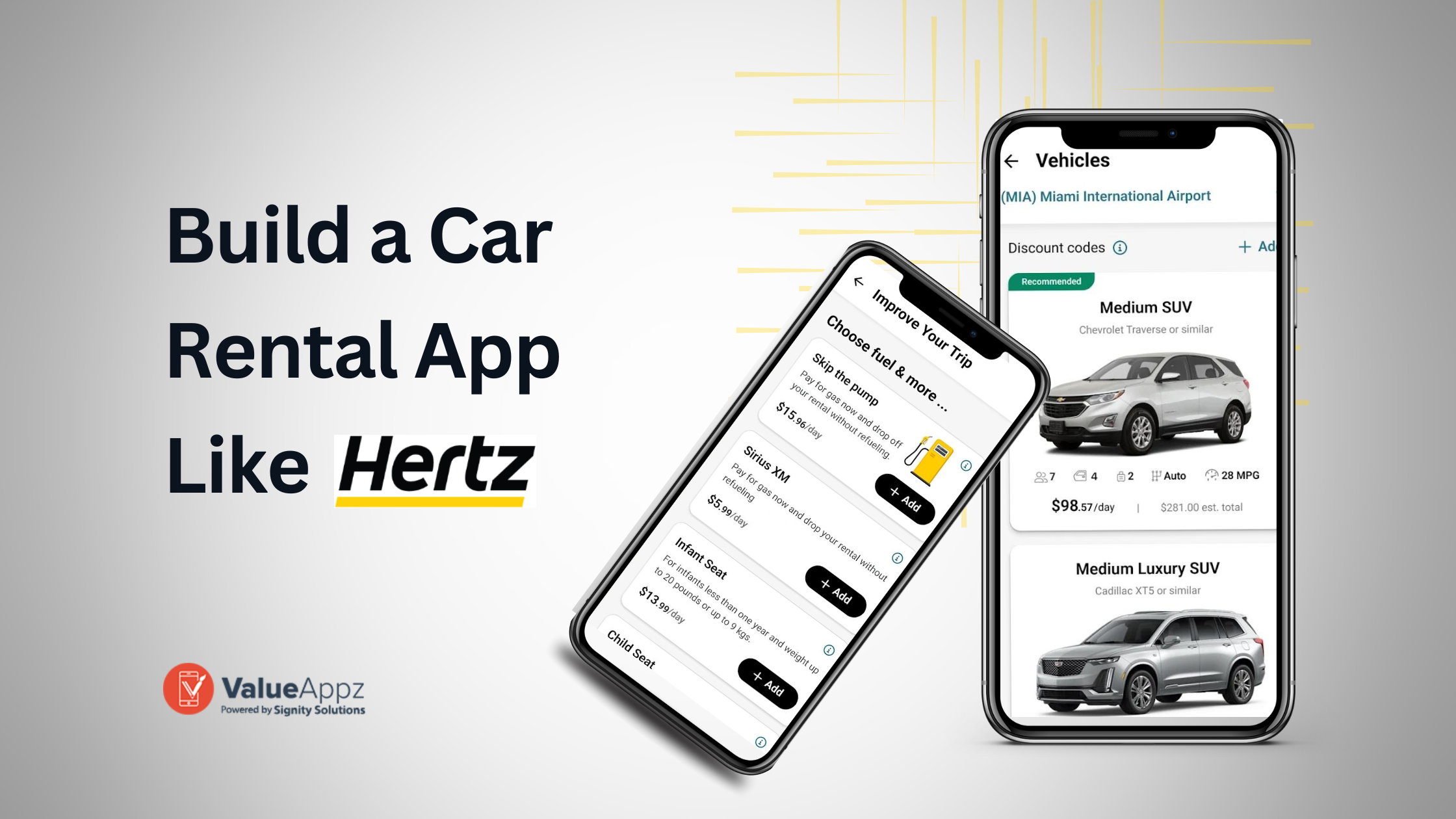How to Develop a Taxi Booking App: A Complete Guide [Updated 2024]

Quick Summary: Building a taxi booking app requires careful planning and strategizing. As a startup, it can be challenging to identify the right steps. Worry not. Our blog will help you discover the step-by-step process for taxi app development. Know everything about the taxi app development cost, market opportunities, and development process.
Taxi apps like Uber, Lyft, and Ola have made traveling and commuting easier than ever. The online taxi booking system has brought so much comfort that people now prefer these services even for covering a short distance rather than going out on the streets to look for a transportation option.
So, if you own a taxi business, converting it into an online platform with an online taxi booking system can be beneficial for your growth. Further, if you are a startup wanting to enter the online taxi industry, building taxi apps like Uber is what you need for success.
Hence, working with the right taxi booking app development services is crucial to ensure that you fill the market gaps.
Before beginning with the online taxi booking app development process, let’s look at the market size and its future growth.
Table of Contents
Market Size and Business Opportunities
Now is the perfect time for building a taxi booking app. This industry is seeing continuous growth in its global users and this high demand is what will help your startup quickly engage the target audience. Along with appropriate marketing strategies and partnership with local cab services, your online taxi booking system can become a go-to platform in no time.
- The studies have proved that the on-demand taxi booking app industry will see booming growth. The projected taxi app value for 2026 is $150 billion.
- In 2022, Uber alone generated a revenue of $31.8 billion, with an 82% increase every year.
- The number of customers for the taxi booking apps is expected to reach 1.45 billion users by 2027 as per the Statista report.

Image Source: Business of Apps

Image Source: Business of Apps
The image above shows how various taxi booking apps have generated great revenue with their top-notch services.
How to Develop a Taxi Booking App- Steps to Follow
Every taxi booking app startup will have the question-”how do I build a taxi app?”. Often entrepreneurs believe that designing and developing an app can be a big challenge as they may lack tech knowledge. However, the taxi booking app development process can be easy when you follow a well-defined procedure.
It starts with learning about the market and moves to designing, developing, and launching the app.
Below, we have explained the whole process in detail that will help startups, small businesses, and enterprises to build an app that engages customers and keeps them coming back to it.
We know you have several questions for starting your online taxi booking system. Check our blog to get all the answers.
Phase 1- Create a roadmap for your taxi booking app
Planning is a crucial step in the taxi app development process. It includes creating a roadmap of what the app would look like and what exact plans you wish to achieve with it.
1. Understand the market and user needs
You must be well aware that numerous giants like Uber and Ola in the market have already captured the majority of customers. Many more such competitors entering the online taxi industry have created tough competition. Further, users have already got solutions for many of their problems.
Hence, how do you plan to stand out from these competitors? What are the market gaps that you wish to cover, and do you recognize the exact user needs? Answering these questions is extremely important for creating a solid plan for your mobile taxi booking app.
2. Identify the target audience
Now that you know how the online taxi market works and what your inputs would be, discover your target audience. Will it be local people, or do you also want to reach out to people from other cities and states? Clearly identifying the target market will enable you to create a taxi booking app the right way.
Some things to consider while discovering your target audience are:
- Analyze the demographics: Consider the age, gender, location, occupation, and other demographic details of your potential users. Recognizing these demographics will help you develop features and marketing plans for your app tailored to their individual requirements.
- Understand the user behavior: Learn more about how people utilize taxis and transportation services. Consider how often they travel, their favorite means of transportation, reasons for utilizing taxis, and usual travel routes. Using this information, you can adjust the features and positioning of your app to meet their unique needs.
- Discover the pain points: Analyze the problems or difficulties that potential customers may encounter when booking and using taxis. It could involve problems like lengthy wait periods, a lack of readily available taxis, or unclear pricing. Addressing these issues may draw consumers looking for a better solution with your app’s features and marketing messages.
Check our blog– The Role of AI in Enhancing Taxi App User Experience to discover the importance of technology in online taxi booking systems.
3. Choose the features to build an engaging app
It’s crucial to establish your target market and list the features you want to include before you begin developing your app. Start by learning about the demands and preferences of your target audience. It will further enable you to create an app that satisfies their needs and offers them a seamless user experience.
Once you have identified your target market for the business, you must choose the features you want to offer in your app. Some essential features that you can consider are:
| Features | Customer app | Admin app | Driver app |
| User registration | ✓ | ✓ | ✓ |
| User profile management | ✓ | ✓ | |
| Real-time tracking | ✓ | ✓ | ✓ |
| Booking and scheduling | ✓ | ✓ | ✓ |
| Fare calculation | ✓ | ✓ | ✓ |
| Payment integration | ✓ | ✓ | ✓ |
| Ratings and reviews | ✓ | ✓ | ✓ |
| In-app messaging | ✓ | ✓ | ✓ |
| Push notifications | ✓ | ✓ | ✓ |
| Multi-language support | ✓ | ✓ | ✓ |
| Driver management | ✓ | ✓ | |
| Driver tracking | ✓ | ✓ | |
| Driver availability | ✓ | ✓ | |
| Trip history | ✓ | ✓ | ✓ |
| Customer support | ✓ | ✓ | ✓ |
| Promo codes and discounts | ✓ | ✓ | |
| Ride sharing/pooling | ✓ | ||
| Heatmap analysis | ✓ | ||
| Reporting and analytics | ✓ |
The above-mentioned features are a must to add to the taxi booking app. But, to make the app even more useful and ensure that it can compete in the market, you can add some advanced features. Advance features to build taxi booking apps that lead the market include:
Split fare: Today, people prefer to share a ride to save money. You can integrate a split fare feature to let them divide the money easily. It can also be helpful for groups of people traveling together.
In-app tipping: Users can tip the driver directly through the on-demand taxi booking app with the in-app tipping feature. Hence, they can show their appreciation for good services.
Live tracking: This feature will enable users to track the live location of their booked taxi. It can be helpful for the customers waiting for the cab to arrive to know the estimated arrival time.
Multilingual support: Your on-demand taxi booking app should include several languages so that there is no barrier across the globe.
Integration with Smart Home Devices: Enable your users to book rides or get updates through voice commands using smart home devices like Google Home, etc. Smart predictive suggestions: Empower the app with ML algorithms to provide predictive suggestions for frequently visited locations, preferred routes, and personalized recommendations.
4. Boost income with the right monetization method
You have planned an engaging taxi booking app, but how would you make money? Or, to put it better, how does Uber make money and generates profit from providing the services? For better ROI, you can choose one or more monetization methods for the app.
These include:
- Commission-based model: By implementing a commission-based model, you can earn a percentage of the fare for every ride. The method will help earn revenue directly from each transaction the app facilitates.
- Subscription model: By offering subscription plans to the users, you can provide additional benefits like discounted fares, priority booking, or access to more exclusive features. Under this, users will pay a recurring fee to keep the subscription.
- Surge pricing: The surge pricing model involves increasing the service rate during peak hours, high demands, and special events. Hence, you can capture more revenue by temporarily increasing the price.
Phase 2- Steps for user-friendly taxi booking app development
Once you have done the market research, studied your competitors, defined the target audience, and listed the essential features of the app, it’s time for taxi booking app development. Below are various steps that you should follow in the development process:
1. Create the app design
The UI/UX is critical in attracting customers and enhancing the retention rate. Start the app development process by creating a wireframe of the app’s interface. The design will help you outshine and get noticed by the target audience. Some design guidelines that you can follow are:
- Simple and intuitive navigation: Make sure the app’s navigation is simple and understandable. Clearly mark each part of the app, such as booking, ride tracking, payment, and profile settings, using labels and symbols. To provide a familiar experience, stick to traditional navigational patterns.
- Clear CTA buttons: Use call-to-action buttons that are visibly appealing and noticeable enough to take actions like ordering a ride or confirming a payment and simple to reach. Use distinct colors that offer quick visual feedback when buttons are tapped.
- Consistent and responsive layout: To create visual coherence throughout the app, keep the layout constant. In addition, content should be organized using a grid system to make the design responsive and easily adjusted to various screen sizes and orientations.
- Minimalist and uncluttered design: Choose a minimalist and clean approach to design to decrease visual clutter. Refrain from overloading users with too much information or unnecessary elements. To increase readability and visual hierarchy, concentrate on displaying the most important information and use whitespace wisely.
2. Develop the app’s features
Once the design for the taxi booking mobile app is finalized, the next step is to develop its features and functionalities. You can either use a low-code or no-code platform to build your app or employ a dedicated development team. Writing the necessary code and adding functions like user registration, ride booking, real-time tracking, fare computation, driver administration, ratings, and reviews are all part of the development process.
To accommodate upgrades and expansions in the future, put your effort into creating a solid and scalable architecture. Further, the right taxi app development company will help you design and develop the app how you want.
3. Integrate payment and security features
As users will be required to make a payment after each ride, the process should be easy to follow. Further, the app should also provide several payment options so that your customers can pay from the source that they trust the most. It can include paying by cash, debit cards, app wallet, or online payment. Doing this will ensure that making the payments is never a problem.
Every on-demand taxi booking app has to be secure as the users will share their personal information like their address, phone number, and other data. This stage is essential for establishing credibility and trust with your users and safeguarding their private data. Hence, the taxi booking app should provide complete security and privacy to the users.
Phase 3- Enhance the app’s potential with the testing phase
Finally, it is time to take your online taxi booking app to potential customers. But before you launch the application in the market, it’s vital to ensure that it functions well and provides all the necessary solutions.
1. Test the app
After the development process is completed, the on-demand taxi booking app will go through the testing stage. The testing process will ensure that the app is bug and error-free. You can test the taxi booking app with a small group of users and take their feedback for improvements.
Some tips for testing your taxi booking app are:
- Test your taxi booking app on a variety of devices and operating systems.
- Test the taxi booking app with several users, including people of different ages, abilities, and backgrounds.
- Test the app in other locations and under different conditions.
- Pay attention to the app’s performance and look for bugs or glitches.
- Ask users for feedback on the app’s usability and design.
2. Launch the app
Once you have tested your app and are happy with it, it’s time to launch it on the app stores. To do this, you must create a developer account and submit your app for review. For this, you must register as a developer with each platform, follow their submission requirements, and submit the required app details, including descriptions, screenshots, icons, and keywords. Once your app has been reviewed and authorized, customers will be able to download it.
3. Market the app and create a buzz
When it launches, you must deploy a thorough marketing plan to draw people to your taxi booking app. Make use of multiple channels to advertise your app and raise awareness of it. For example, social media sites can be utilized to interact with prospective customers, disseminate app updates, and launch specialized advertising efforts.
To increase the app’s exposure in search engine results, use search engine optimization (SEO) strategies. Reaching a larger audience can also be aided by paid advertising, such as targeted adverts or app install efforts. Additionally, to raise brand recognition and encourage app downloads, think about using collaborations with nearby companies, influencers, or taxi service providers.
Technology Stack for On-Demand Taxi Booking App Development
A well-planned tech stack that includes both the frontend and backend elements is needed to build a taxi booking app. For instance, at ValueAppz we use the latest technologies for taxi booking app development. These include:
| Frontend | Backend | Pre-integration |
|
Mobile app development: Flutter is the best technology for the front end of mobile app development. Its single codebase for both Android and iOS enables faster development and a consistent user experience. |
The backend is equally important to ensure that the platform works smoothly and error-free. Hence, you need the right tech, like Node.js, for the Backend development. Its event-driven, non-blocking I/O enables efficient handling of simultaneous connections and high performance. | Our pre-integration services ensure that the app has all the necessary integrations like online payments, GPS, calendar and scheduling, and communication tools. |
|
Web development: Various tech stacks like React, Node, and Next.js can help develop an engaging front. These technologies empower developers to build interactive user interfaces with reusable components. |
What is The Taxi App Development Cost?
How much does it cost to make a taxi app? It is one of the first questions when entrepreneurs plan to start an online taxi business. Taxi booking app development costs can vary from $15,000-$60,000. Developing an app can be tricky, but it requires the latest tech stack, valuable experience, sufficient time, and knowledge of skilled on-demand mobile app developers.
The table below shows the factors that affect the cost of a taxi booking app.
| Factors | Description |
| App features | The complexity and number of features to be added to the app. |
| Design and user interface | Level of customization and design complexity. |
| Platform and device compatibility | Choice of the platforms (iOS, Android) and device compatibility (smartphone, tablet, etc.). |
| Backend development | The complexity of building server infrastructure, database, APIs, and integration of third-party services. |
| Payment gateway integration | The number of supported payment methods. |
| Geolocation services | Integration of mapping and geolocation services. |
| Multilingual support | Requirement for supporting multiple languages in the app. |
| Testing and quality assurance | The level of testing required to ensure app stability, performance, and security. |
| App maintenance and support | Cost of recurring app maintenance, bug fixes, updates, and support services. |
| Development team | The choice between in-house and hiring an external development team. |
Maximize Revenue With a Custom Taxi Booking App
Are you planning to build a taxi booking app for your startup or existing business? Unlock the potential of your taxi business by taking it online with an engaging app. At ValueAppz, we understand all the challenges you may face in a competitive market and your need to stay ahead of the competition. As a result, our taxi booking app developers excel in creating robust, feature-rich, and user-friendly taxi booking apps that can streamline operations.
Our on-demand delivery app development services will help you create an app that brings out the desired results.
Do not miss the great opportunities to take your taxi business to the next level. Contact our team now for the best and most customized solutions for your business at the right budget.
Key Takeaways
- The growing online taxi market offers a fantastic chance for entrepreneurs. The time is right to release a taxi booking app, with a predicted value of $150 billion by 2026 and a growing user base.
- Effective app development requires an in-depth knowledge of user demands and market research. Customizing features and methods for optimal effect and competitiveness requires an understanding of target demographics and market gaps.
- Selecting features carefully can enhance user engagement and experience. Along with advanced functions like split fare and in-app tipping, your app can stand out from the competition and draw in customers with features like real-time tracking and payment integration.
- For sure income creation, use efficient monetization techniques like surge pricing and commission-based models. The secret to long-term success is striking the correct balance between profitability and user value.
Frequently Asked Questions
Q1. How can I build my own taxi app?
To create your own taxi booking app solution, you need to start with planning and research. Further, an experienced team of on-demand app developers can help you design and build the app how you want.
Q2. How much does it cost to build a taxi app?
The average cost of developing a taxi booking app can range from $15,000-$60,000. The price can change depending on factors such as features, app complexity, time required, and so on.
Q3. How to build a taxi booking app like Uber?
You must understand its model well to build a taxi app like Uber. Also, Uber clone apps can be the best way to develop a taxi booking app like Uber with some necessary customizations.
Q4. What are the top 5 features of a taxi booking app?
The top features that your taxi booking app should have are GPS navigation, real-time tracking, push notifications, ride-sharing, and in-app messaging for a seamless experience.
Q5. How many stages are there in the taxi app development process?
There are a total of three stages-planning, building, and launching the app. Each stage has several steps to be followed to build an engaging app.
💡 Editor’s Note: This blog entry was originally published on May 19, 2023, and is updated on March 20, 2024.
THE AUTHOR
Harjyot kaur
As a technical content writer my focus is on creating high-quality, engaging, and informative content that simplifies complex technical topics. Throughout my career, I have continuously pursued opportunities for growth and development, refining my skills and expanding my knowledge base.

Get ready to digitally transform your business.
Let our team help take your business to the next level. Contact us today to get started on finding the perfect solutions for your business needs.











